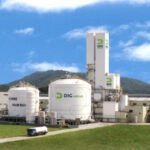Samsung Electronics semiconductor complex in Taylor, Texas under construction (File photo by EPA/Yonhap)
South Korean manufacturers moved abroad as electricity bills were higher by about 30% than those of major economies such as the US and China after the government ramped up power prices.
South Korean manufacturers were estimated to have paid 41.6 trillion won ($30 billion) for power last year, 61.8% up from the 25.7 trillion won in 2020, according to an analysis on Monday of the Federation of Korea Industries requested by The Korea Economic Daily.
The semiconductor sector’s electricity costs rose 62.9% to 9.3 trillion won during with Samsung Electronics Co. estimated to have spent 1.7 trillion won more. South Korea is home to the world’s two largest memory chipmakers – Samsung and SK Hynix Inc.
Electricity expenses of the petrochemical industry, basic metal sector and automobile industry increased by 2.4 trillion won, 2.1 trillion won and 1.1 trillion won, respectively.
That came as the government pushed up electricity bills for industrial uses, which apply to manufacturers in Asia’s fourth-largest economy, by 63.3% with seven hikes to 153.5 won per kilowatt-hour (kWh) last November from 94 won in December 2020. That compared with 112 won per kWh in the US and 116.6 won in China.
South Korea’s industrial power prices were lower than those of the world’s top two economies in 2021 as the country charged 94 won per kWh in December 2021, compared with 99.8 won in the US and 114.7 won in China.
The escalating electricity bills were another reason South Korean manufacturers moved abroad, which have already suffered from high corporate tax rates, tough regulations and fewer incentives.
US ALLURES MAJOR COMPANIES
The US, the world’s largest economy, is attracting major South Korean manufacturers with lower electricity bills, in addition to incentives and subsidiaries.
The states of Texas and Georgia where Samsung, Hyundai Motor Co., LG Energy Solution Ltd. and SK On Co. operate plants, provide electricity at half the prices of South Korea. Texas and Georgia charge only 77.6 won per kWh and 83.4 won, respectively.
Samsung, the global memory chip leader, is building a semiconductor complex in Taylor, Texas. Hyundai, the world’s No. 3 automaker along with its affiliate Kia Corp., is establishing an electric vehicle plant in Bryan County, Georgia. Battery makers LG Energy and SK On are also setting up facilities in the state.
Hanwha Q Cell Co., a solar power unit of South Korea’s chemicals-to-defense conglomerate Hanwha Group known as Qcells in overseas markets, established a solar energy hub in Cartersville, Georgia.
Qcells production complex in Cartersville, Georgia (File photo by Hanwha Q Cells)
“In the past, Korean companies moved out of the country mainly due to strict regulations and high corporate tax rates, but more local firms now mention expensive power bills,” said an industry source said.
European countries lowered electricity prices to keep domestic companies from leaving. Germany cut taxes on power bills as the country’s manufacturers relocated their production bases to other nations due to the surging electricity costs.
The government decided to slash duties on power bills by 97% last November while considering providing subsidiaries when electricity costs top 0.06 euro ($0.07) per kWh.
SOUTHEAST ASIA
OCI Holdings Co., South Korea’s maker of polysilicon for solar panels, in March 2022 decided to move its local facilities to Malaysia as power prices, which made up 40% of its production costs, rose too much to compete with its Chinese rivals.
Electricity bills in Sarawak where the company operated a polysilicon factory are about a third of South Korea with 41.2 won per kWh at night and 65.2 won in daytime. Industrial power costs averaged at around 100 won per kWh in Malaysia, but the Sarawak authorities cut the prices to manufacturers there as incentives.
“Production costs of OCI Holding’s Malaysian unit are likely to be less than half of those in Korea, given lower power bills and corporate tax cuts,” said an industry source in Seoul. “There are fewer reasons to do business in Korea as time goes by.”
OCIM’s polysilicon factory in Sarawak, Malaysia (File photo by OCIM, OCI Holding’s wholly owned subsidiary in Malaysia)
Other Southeast Asian countries such as Vietnam and Indonesia where many South Korean companies operate production facilities supply electricity at cheaper prices. Power costs for industrial uses in those nations are around 100 won per kWh, but local authorities lower the costs to around 60-70 won.
That prompted SK Nexilis Co. and Lotte Energy Materials Corp., makers of copper foil for electric vehicle batteries, to operate plants in the region.
By Sang Hoon Sung, Woo-Sub Kim and Hyung-Kyu Kim
uphoon@hankyung.com
Jongwoo Cheon edited this article.















